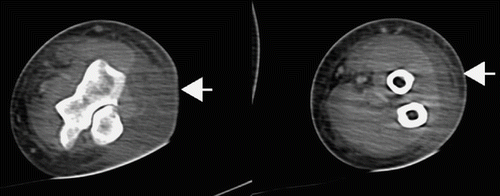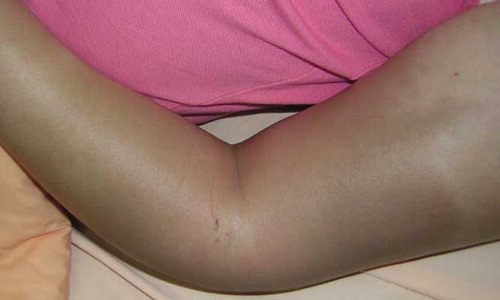Abstract
Introduction. Glyphosate-surfactant herbicide (GlySH) is widely used as a non-selective herbicide. Most intoxicated cases are from ingestion, inhalation, and skin exposure. Intramuscular injection of GlySH has never been reported. We present a case of GlySH intoxication via intramuscular injection. Case Report. A 42-year-old woman came to the emergency department complaining of painful swelling of left upper limb for 12 h. She had performed an intramuscular injection of 6 mL of GlySH over the lateral aspect of the left elbow 15 h previously. Physical examination disclosed painful swelling over left distal arm, elbow, and forearm with three needle punctures. CT scan revealed ill-defined areas of heterogeneous high density with marked swelling at subcutaneous tissue over posterior aspect of the elbow. Discussion. The mechanism of toxicity of GlySH is complicated and surfactant was thought to play an important role in GlySH intoxication. Intramuscular GlySH poisoning is different from oral GlySH intoxication. Care should be taken when monitoring acute rhabdomyolysis and compartment syndrome, which may develop rapidly and contribute to the surfactant component of glyphosate formulation.
Introduction
Glyphosate-surfactant herbicide (GlySH) is used widely as a non-selective herbicide (Citation1). Accidental ingestion of GlySH is generally associated with mild and transient gastrointestinal disturbance, but ingestion of 200 mL or more results in a poorer outcome (Citation2–4). Inhalation produces a raspy feeling of the throat and upper respiratory tract irritation, and GlySH causes erythema, piloerection, and contact dermatitis following skin exposure (Citation5). Intravenous administration of GlySH has been reported and acute hemolysis has been noted (Citation6). Because intramuscular injection of GlySH has never been reported, we present a case of intramuscular injection of GlySH.
Case report
A 42-year-old woman presented to the emergency department complaining of progressive painful swelling of her left arm for 12 h. She had injected 6 mL of GlySH into the muscles over the lateral aspect of the left elbow in a suicide attempt 15 h previously. On arrival, her state of consciousness was normal. Her blood pressure was 117/63 mmHg, pulse rate 101 beats/min, respiratory rate 17 breaths/min, and body temperature 36.5°C. She had tender swelling of left distal arm, elbow, and forearm with three needle punctures (). Capillary refill time was 2 s, and her left hand was warm with strong radial, ulnar, and brachial artery pulses. The electrocardiogram showed non-specific S-T segment changes. Abnormal laboratory results present on admission were leukocyte count 11.6 × 109/L, creatine phosphokinase (CPK) 1,743 IU/L (reference 10–160 IU/L), C-reactive protein 12.3 mg/dL (reference < 0.5 mg/dL), and arterial pH 7.43, PaCO2 35.4 mmHg, HCO3− 24.1 mEq/L. Hemoglobin and serum potassium, creatinine, lactate dehydrogenase were normal. Computed tomography (CT) of left upper extremity revealed ill-defined areas of heterogeneous high density with marked swelling noted in subcutaneous tissue over the posterior aspect of the elbow and reactive subcutaneous edema and thin fluid collection along the deep fasciae over distal upper arm, elbow, and proximal forearm suggestive of cellulites. After urine alkalinization therapy, the CPK fell to 1,289 IU/L the next day. The swelling of left arm improved gradually and the patient was discharged 4 days later without sequelae.
Discussion
Commercial glyphosate-based formulations marketed for residential use most commonly range from 1% (ready-to-use) to concentrates with more than 41% glyphosate. The most common concentrate is the 41% formulation. They generally consist of an aqueous mixture of the isopropylamine (IPA) salt of glyphosate, a surfactant, and various minor components including anti-foaming and color agents, biocides, and inorganic ions to produce pH adjustment (Citation1).
Ingestions of substantial volumes of GlySH have been associated with a 7.5–16.1% mortality rate in humans (Citation2,Citation4,Citation5,Citation7). In addition to glyphosate, surfactant was thought to play an important role in GlySH intoxication. Wu et al. (Citation6) reported a case of deliberate self-poisoning through intravenous injection of GlySH, and the patient developed acute hemolysis. As in our case with intramuscular GlySH, the poisoning differed from oral intoxication, with muscle cell damage and tissue lysis near the puncture sites.
There are four highly associated predictors of poor outcomes and mortality following oral ingestions and systemic intoxication: respiratory distress, pulmonary edema, renal injury or acidosis requiring hemodialysis, and hyperkalemia (Citation2). Large amounts and suicidal intent could contribute to these factors. Because our case is limited to local injury by GlySH, there were no systemic toxicities such as renal injury, hyperkalemia, or respiratory distress. The prognosis was thus considered fair after treatment although the predictive value of these factors following injection has not, of course, been validated.
Compartment syndrome of the upper arm is infrequent because of the relatively thin fascia of the arm compared to that of the forearm or leg (Citation8). Our patient presented with painful arm swelling. Rhabdomyolysis with muscle swelling was noted, which has not been reported in either oral or dermal poisoning. The mechanism of systemic and local toxicity of GlySH is complicated, but it is likely that there was a GlySH-induced muscular inflammatory process () in our patient.
Fig. 2. Reactive subcutaneous edema and thin fluid collection along the deep fasciae are noted over distal upper arm, elbow, and proximal forearm (white arrows).

Physical examination disclosed normal capillary refilling time and preserved distal arterial pulsation. Although compartment syndrome did not occur in this case, such complications may develop rapidly after injection of foreign substances. Careful observation for compartment syndrome would be appropriate in the event of GlySH injections.
Conclusion
We report the first case of intramuscular GlySH poisoning. Local inflammation and rhabdomyolysis follow after local injury, so it is important to monitor and observe the patient frequently.
References
- SM Bradberry, AT Proudfoot, and JA Vale. Glyphosate poisoning. Toxicol Rev 2004; 23:159–167.
- HL Lee, KW Chen, CH Chi, JJ Huang, and LM Tsai. Clinical presentations and prognostic factors of a glyphosate-surfactant herbicide intoxication: a review of 131 cases. Acad Emerg Med 2000; 7:906–910.
- CM Lin, CP Lai, TC Fang, and CL Lin. Cardiogenic shock in a patient with glyphosate-surfactant poisoning. J Formos Med Assoc 1999; 98:698–700.
- RL Tominack, GY Yang, WJ Tsai, HM Chung, and JF Deng. Taiwan National Poison Center survey of glyphosate-surfactant herbicide ingestions. J Toxicol Clin Toxicol 1991; 29:91–109.
- AR Talbot, MH Shiaw, JS Huang, SF Yang, TS Goo, SH Wang, CL Chen, and TR Sanford. Acute poisoning with a glyphosate-surfactant herbicide (“Roundup”): a review of 93 cases. Hum Exp Toxicol 1991; 10:1–8.
- JY Wu, SS Chang, CP Tseng, JF Deng, and CC Lee. Parenteral glyphosate-surfactant herbicide intoxication. Am J Emerg Med 2006; 24:504–506.
- Y Sawada, Y Nagai, M Ueyama, and I Yamamoto. Probable toxicity of surface-active agent in commercial herbicide containing glyphosate. Lancet 1988; 1:299.
- DM Knapke, and E Truumees. Posterior arm and deltoid compartment syndrome after vitamin B12 injection. Orthopedics 2004; 27:520–521.

